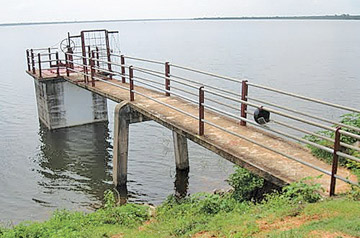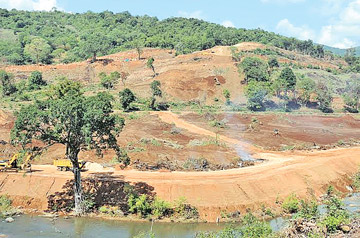|

The Moragahakanda reservoir shuttle dam under construction |
Water facilities to 82,000 ha of lands :
Major irrigation projects for the North
By P. Krishnaswamy
The major Moragahakanda-Kaluganga Development Project (MKDP), now on
an accelerated pace will, on completion in the next six years, mark a
very significant milestone under the Mahaveli development projects,
bringing thousands of acres of cultivable lands under the plough along
its long course to the North Central and the Northern provinces, while
also fulfilling the Northern people's long-awaited need of water for
drinking and domestic use.
The capacity of the two reservoirs is almost six times the size of
the Parakrama Samudra and it is second only to the Victoria Dam and
Hydro Power Project, according to project authorities.
The significance of the project assumed new dimensions when President
Mahinda Rajapaksa, during his historic visit to Jaffna on October 13 to
inaugurate the resumption of the Yal Devi train service after 24 years,
told people that waters of the Moragahakanda-Kaluganga project, under
the Mahaveli development, will feed the Iranamadu tank in Kilinochchi to
fulfil their water requirement.
The MKDP, although formulated more than four decades ago under the
Mahaweli Master Program, did not see the light of the day due to various
reasons. However, it was later included in the "Mahinda Chintana"
Development Program and President Mahinda Rajapaksa laid the foundation
stone on January 25, 2007, the sources said.
|

The Hurulu Wewa tank in the NCP |
|

Construction work in progress at the Kaluganga dam site |
Explaining to the Sunday Observer the progress that the project has
made until now and the salient features of the project, Secretary to the
Ministry of Irrigation and Water Resources Management Eng. K.W. Ivan de
Silva and Project Director R.B. Tennakoon provided the following
details:
The total investment for this major project is a staggering US $ 2.1
Billion although, according to the original estimates, the amount was US
$ 650 Mn. The two reservoirs, the Moragahakanda and the Kaluganga
reservoir, are to be constructed at the initial stages and the work is
now in progress.
Funding for the second stage link canal construction will be obtained
also from the Asian Development Bank (ADB).The total number of families
getting displaced due to inundation of their places of residence, under
the two projects, is 2,500. An amount of US $ 125 Mn or more will be
spent on the relocation/rehabilitation of the families.
The project will be implemented in several stages phased over a
period of the next six-eight years. Construction of the Moragahakanda
Reservoir with funds raised from the China Development Bank is now in
progress and the world's leading construction company, the Sinohydro
Corporation of China, is entrusted with the construction work.
The construction of the Kaluganga Reservoir is to be undertaken with
funding from the Kuwait Fund for Arab Economic Development (KFAED), the
Saudi Fund for Development (SFD) and the OPEC Fund for International
Development (OFID). The local inputs are from the engineers of the
Irrigation Department which would save millions of rupees to the
national coffers.
Hurulu Wewa
The Kaluganga and the Morakahakanda reservoirs will be linked by a
link tunnel about nine kilometers (km) in extent and comprises 8 km of
tunnelling.
The Hurulu Wewa reservoir in the North Central province will be
linked by the Upper Elahera canal. Kaluganga-Moragahakanda Transfer
Canal (KMTC) will convey up to 771 MCM of water annually between
Kaluganga and Moragahakanda Reservoirs, both of which are under
construction.
The Upper Elahera Canal (UEC) will annually convey up to 974 MCM
northwards from Moragahakanda Reservoir, along a 70 km canal (including
about 20km of tunnels and 16 km of cut-cover conduits), to the existing
Huruluwewa and Mannakattiya Reservoirs, which feed existing irrigation
and water supply schemes.
At the final phase the water will be transferred to the
Kanagarayankulam tank and from there to the Iranamadu tank in
Kilinochchi and will eventually augment drinking water supplies to
Jaffna and Kilinochchi.
The Iranamadu reservoir will get 100 MCM water annually. This, in
turn, will help towards further uplifting the socio-economic welfare of
the people people of the North ravaged by nearly 30 years of terrorism.
|

A closer view of the surroundings of the Kaluganga main dam
site |
|

A panoramic view of the surrounding hilly terrain of the
Kaluganga main
dam site where the reservoir construction has already begun |
One important feature is that when the water reaches the Iranamadu
reservoir and from there to areas of Kilinochchi and Jaffna, there will
be no declaration, whatsoever, of Mahaveli Zone Development zone or
acquiring of land rights.
Initial stage
The Moragahakanda-Kaluganga Development project is to provide
irrigation for agriculture and water for domestic and industrial use in
Central, North central, Eastern, North and North Western provinces of
Sri Lanka.
Generation of electricity by hydro power (25 MW), Development of
inland fisheries, promotion of eco tourism and flood control in lower
basins in the dry zone are other objectives that are to be fulfilled
under this project.
At the initial stage, with the construction of Moragahakanda and the
Kaluganga reservoirs, it will become possible to provide irrigation
water facilities to 82, 000 ha of lands for both Yala and Maha seasons
and domestic and industrial water to Anuradhapura, Polonnaruwa,
Trincomlee and Matale districts.
Here about 5,000 ha of new lands for agriculture will be open up and
developed under the project. The North Central Province canal (NCP
canal) will successfully irrigate 135,189 ha of new and prevailing
agricultural lands for both seasons in eight river basins at North and
North Central Provinces. To facilitate this activity 8 tanks have been
planned to be construct in eight river basins in the area. The
Moragahakanda-Kaluganga Development project is to provide irrigation for
agriculture and water for domestic and industrial use in Central, North
central, Eastern, North and North Western provinces of Sri Lanka.
Generation of electricity by hydro power (25 MW), Development of
inland fisheries, promotion of eco tourism and flood control in lower
basins in dry zone are another objectives that are to be fulfilled under
this project.
With the completion of first stage construction activities of the
Moragahakanda-Kaluganga Development Project, it will be possible to
provide irrigation water facilities to 82, 000 ha of lands for both Yala
Maha seasons and domestic and industrial water to Anuradhapura,
Polonnaruwa, Trincomlee and Matale districts.
Here about 5,000 ha of new lands for agriculture will be open up and
developed under the project. Cropping intensity will be enhanced from
100 percent to 154 percent in the Development Area. With the
implementation of the project it will be increased up to 181 percent on
the average.
Direct benefits include increased rice yield per hectare with an
additional agricultural production of 123,000 tons annually. The net
annual agricultural benefits will be US $ 30.1 million in monitory
terms. The average annual fish production potential of the reservoirs is
estimated to be around 4,700 tons per year, representing a net benefit
US $ 1.67 million annually. The annual fuel cost savings with the hydro
power production will be around US $ 2.49 million on an annual average.
|

